Spiny McSpleen's Nifty

WEBPAGE
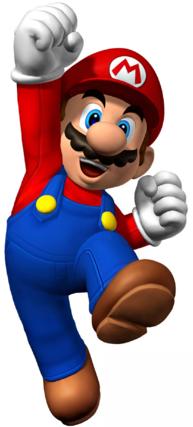 ABOUT MARIO
ABOUT MARIO
In 1981, a new employee at Nintendo, named Shigeru Miyamoto, created an arcade game entitled Donkey Kong. The hero was a high-jumping carpenter, known as "Ossan" (Japanese, "middle-aged man"), later "Jumpman". The game was wildly successful in Japan, so a Nintendo branch was begun in the United States, to oversee American distribution of Donkey Kong. Dissatisfied with the name "Jumpman", Nintendo of America (as it was called) searched high and low for a new name for the character. Eventually, the answer came in the form of Mario Segali, the Italian landlord of NoA's headquarters; Segali interrupted a staff meeting to demand a late rent payment. And so ends the story of Jumpman, and begins the legacy of Mario.
Donkey Kong achieved unmatched success in the United States also, and was followed up by a sequel, of sorts. Mario changed professions, from carpenter to plumber, and went into the sewers -- this time, his enemy was not a giant simian, but rather a horde of evil turtles and crustaceans that emerged from the pipes. The game was entitled Mario Bros, indicating two-player support... and that Mario gained a sibling, named Similar in Japan, given the Mario family resemblance. Similar became Luigi, however, after the American release of Mario Bros.
During Mario Bros's arcade run, Nintendo branched out into home videogame consoles, creating the Family Computer, or "Famicom" (called "Nintendo Entertainment System", or "NES" for short, in the other markets). For this new system, a new incarnation of Mario was made, in Super Mario Bros. This time, Mario and Luigi discovered the source of the sewer monsters: one of the pipes led to a place called the Mushroom Kingdom. The rest is history.
Since then, Mario has appeared in a host of other games, mostly in a starring role, saving the princess -- though, on two occasions, it was he who needed saving! Sometimes, Mario would be on the sidelines, rather than a part of the action. Over the years, he has taken the role of referree, doctor, golfer, race-car driver, and numerous other occupations.
THE VOICE OF MARIO
The first time Mario needed a voice was for The Super Mario Bros. Super Show!! in 1989. The show was in two parts: an animated section, showing the Mario Brothers' adventures in the Mushroom Kingdom, and a live-action section which took place in Brooklyn and made no reference to the Mushroom Kingdom. In both sections, Mario was played by former WWF manager, Lou Albano. In the 1993 live-action film, Super Mario Bros., which was very loosely based on several Mario games, Mario was played by English actor, Bob Hoskins. A year prior, a trade-show presenter by the name of Charles Martinet uttered the phrase, "It's-a me -- Mario!", for the first time at a trade-show in California. He has been the voice of Mario, Luigi, and several other Mario characters in all official Nintendo material since.
MARIO AND LUIGI
Luigi is Mario's younger brother. He has spent a great deal of time in Mario's shadow, being known as the "sidekick", "Mr. Lime-Green", "Mario's brother", and "Mario" (when people mistake him for Mario). Regardless, the Mario Brothers frequently team up to go adventuring, defeat an enemy, or play a sport. Luigi appears to have a great respect for his brother, stating on various occasions that he wishes he could go adventuring with him more often. In Luigi's Mansion, Luigi was tasked with rescuing Mario from the clutches of King Boo.
MARIO AND SONIC
In 1991, Mario gained a rival: Sonic the Hedgehog. Just as Mario was Nintendo's mascot, Sonic was the mascot of rival game company, Sega. For a half-decade, Mario and Sonic were no less than archnemeses, each fighting the other for the number one spot in videogame popularity. Eventually, after Nintendo made an unfortunate business error involving Sony Electronics, Inc., Sonic simply faded away. In 2001, the two rivals called an uneasy truce, when Sega (now a software developer) released Sonic Heroes on Nintendo's GameCube. Mario and Sonic, though certainly not friends, now seem to co-exist silently on the same gaming system, even going so far as to compete against each other at the Olympics. Thus far, they have attended the 2008 Beijing games and the 2010 Vancouver games.
MARIO AND WARIO
In 1992, Mario's kingdom of Mario Land was very suddenly usurped by a person called Wario. No one knows exactly how, but Wario simply entered the kingdom, decided he wanted his own castle, and stole Mario's. Though Mario was able to oust Wario from the throne, the two have been at the other's wit's end ever since. It is not known where Wario came from, precisely who he is, or what his relationship to Mario might be, but for some reason, he absolutely despises Mario.
Also, it should be noted that Mario's kingdom and all evidence that Mario ever lorded over anything has disappeared without a trace.
MARIO AND PRINCESS PEACH
Princess Peach is the person whom Mario must save from the clutches of Bowser on a semi-regular basis. Over the years, Mario has rescued Peach around about a dozen times. It is not explicitly known what their relationship is, though Rosalina, protector of the cosmos in Super Mario Galaxy, refers to Peach as Mario's "special one". Despite Nintendo's silence on Mario and Peach's relationship, the gaming community at large generally assumes that the two are anything from love-interests to husband and wife. Some fan-fiction writers have even gone so far as to say that Baby Mario (explained below) is actually Mario and Peach's son.
Officially, Shigeru Miyamoto has not provided any information about Mario and Peach's relationship outside of established canon. Judging from how they interact with one another on-screen, the two characters are simply good friends.
BABY MARIO
First appearing in Super Mario World 2: Yoshi's Island in 1995, Baby Mario is a younger incarnation of Mario. Mario & Luigi: Partners in Time seems to support that theory, in that the Mario Brothers travel through time and meet Baby Mario and Baby Luigi in the past.
Baby Mario and Baby Luigi have appeared alongside Adult Mario and Luigi in several Mario-based sport-related games, such as Mario Kart: Double Dash!!, Mario Golf, and Mario Power Tennis. However, the sport games are not considered a part of the Mario canon, as they have no storyline.
SELECTED VIDEOGAME APPEARANCES
Blue text indicates an appearance of Baby Mario
Red text indicates an appearance of both Baby and Adult Mario
Green text indicates a secondary role
1981
Donkey Kong
1983
Mario Bros.
1985
Super Mario Bros.
1986
Donkey Kong, Jr.
1988
Super Mario Bros. 2
1989
Super Mario Land
1990
Dr. Mario
Super Mario Bros. 3
1991
Super Mario World
NES Open Tournament Golf
1992
Super Mario Kart
Mario Paint
Super Mario Land 2: 6 Golden Coins
Mario is Missing!
Mario's Time Machine
1993
Super Mario All-Stars
1995
Mario's Tennis
Mario Clash
Super Mario World 2: Yoshi's Island
1996
Super Mario 64
Super Mario RPG: Legend of the Seven Stars
1997
Game & Watch Gallery
Mario Kart 64
1998
The Legend Zelda: Ocarina of Time (easter-egg)
Game & Watch Gallery 2
1999
Super Mario Bros. Deluxe
Game & Watch Gallery 3
Mario Golf
Super Smash Bros.
2000
Mario Tennis
2001
Paper Mario
Mario Kart: Super Circuit
Super Mario Advance
Luigi's Mansion
Super Smash Bros. Melee
2002
Super Mario World: Super Mario Advance 2
Super Mario Sunshine
Game & Watch Gallery 4
2003
Super Mario Bros. 3: Super Mario Advance 4
Mario Kart: Double Dash!!
Mario & Luigi: Superstar Saga
Mario Golf: Toadstool Tour
2004
Mario vs. Donkey Kong
Mario Golf: Advance Tour
Paper Mario: The Thousand-Year Door
Mario Pinball Land
Mario Power Tennis
Super Mario 64 DS
2005
Mario Superstar Baseball
Dance Dance Revolution: Mario Mix
Mario Kart DS
Mario Tennis: Power Tour
Mario & Luigi: Partners in Time
Mario Smash Football
NBA Street V3
SSX On Tour
2006
Game & Watch Collection
Super Princess Peach
New Super Mario Bros.
Mario Hoops 3-on-3
Mario vs. Donkey Kong 2: March of the Minis
Yoshi's Island DS
2007
Super Paper Mario
Super Mario Galaxy
Mario Strikers Charged Football
Mario & Sonic at the Olympic Games
TRIVIAL INFORMATION
Unlike Luigi, Mario has been featured in at least one game per year since 1981.
In the games, while other characters' voices have changed, Mario's voice has remained roughly the same since 1995.
Charles Martinet's "Mario" voice was based on a character he played in a production of William Shakespeare's, The Taming of the Shrew.
Shigeru Miyamoto graduated university with a degree in industrial technology -- as such, he concerns himself with function, rather than form. Mario, himself, is no exception. His distinctive appearance arose from technological constraints in the early 1980s. He was given overalls so his arms would not disappear into his shirt when he moved; he was given a moustache because there was no room on the sprite for a mouth; he was given a hat because it was not possible to animate hair.
Miyamoto-san suggested that "Jumpman" be called "Mr. Video". However, when "Mario" was suggested, he preferred it. According to a 2009 interview posted on Nintendo's website, Miyamoto has considered that, in retrospect, "Mr. Video" would not have been a very good name, likely driving the character into obscurity.
Mario has appeared somewhere in nearly every third-party game made specifically for a Nintendo system, though never as an active character -- usually as an easter-egg.
A Mario-themed version of the board games Monopoly and Cluedo (also called Clue) exist.
March 10th is known as Mario Day. The reason is because if the date is abbreviated, it becomes "MAR10".
MARIO PICTURE GALLERY

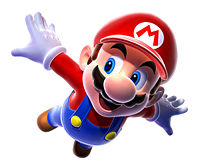
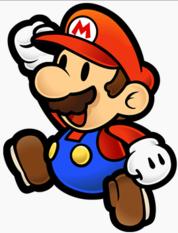

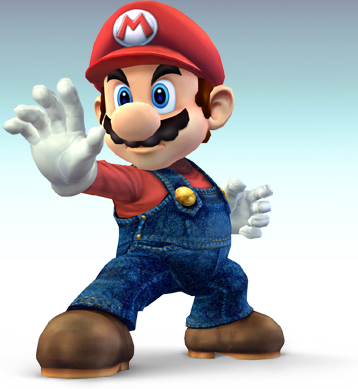
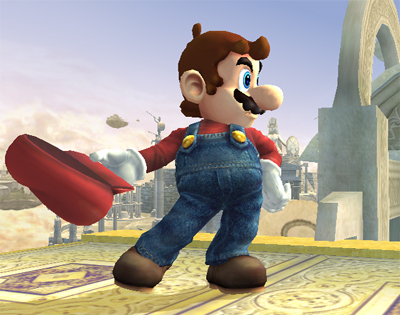
RELATED LINKS
Spiny McSpleen's Nifty Luigi Page
"Mario in Real Time", Mario does movie impressions
The Official Nintendo Website
Mario from Wikipedia, the Free Encyclopedia
Mario's Super Smash Bros Brawl character page
HOME
Copyright © 2007-2009 SebasTECH, Ltd. Page coding and layout by J. Sebastian Perry (a.k.a. Spiny McSpleen).
Mario and all related indicia, Copyright © 1981-2007 Nintendo











